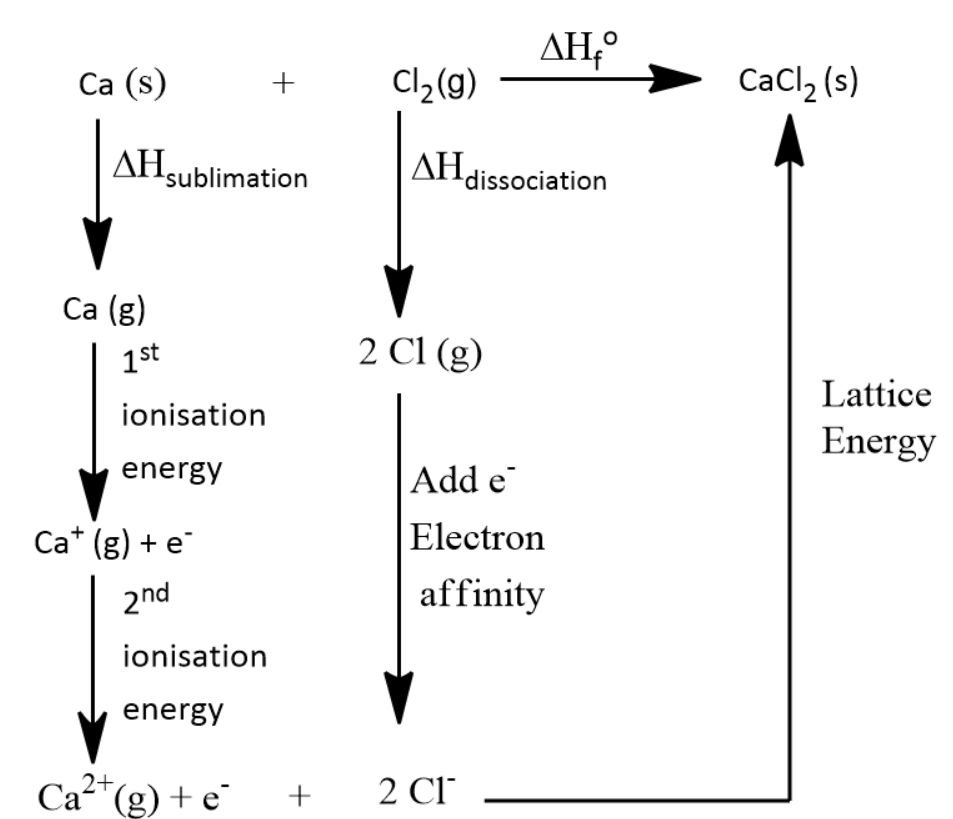
What is the lattice energy of Calcium Chloride?
Answer
402.6k+ views
Hint :The Born-Haber cycle is a very useful method in calculating the lattice enthalpy of any compound. To find out the lattice enthalpy we need the total ionization energy when the compound is prepared from its constituent atoms or ions. We also need sublimation energy, dissociation energy, ionization energy and electron affinity values.
Complete Step By Step Answer:
Let us first consider the Born-Haber Cycle of $ CaC{l_2} $ . Only by seeing this we can calculate the lattice energy of the compound.

By the above diagram we can say that
Standard enthalpy of formation ( $ \Delta H_f^o $ ) = lattice energy + (2 $ \times $ Electron affinity for chlorine) + Bond Energy of Chlorine gas + first and second ionisation energy of calcium + Sublimation energy of Calcium solid.
$ \Delta {H_{{\text{sublimation}}}}{\text{ }} = {\text{ }}121{\text{ }}kJ $
1st Ionization Energy of Ca = 589.5 $ kJ $
2nd Ionization Energy of Ca = 1145 $ kJ $
Bond Energy of Cl2 = 242.7 $ kJ $
Electron Affinity for chlorine = 2 $ \times $ (−349 $ kJ $ )
Standard Enthalpy of Formation of CaCl2 (s) = −795 $ kJ $
We can substitute these values in the equation to find out the lattice energy
$ \Rightarrow - 795{\text{ }}kJ{\text{ }} = {\text{ Lattice Energy }} + {\text{ }}2 \times \left( { - 349{\text{ }}kJ} \right){\text{ }} + {\text{ }}242.4{\text{ }}kJ{\text{ }} + {\text{ }}1145{\text{ }}kJ{\text{ }} + {\text{ }}589.5{\text{ }}kJ{\text{ }} + {\text{ }}121{\text{ }}kJ $
$ \Rightarrow {\text{Lattice Energy = }} - 795{\text{ }}kJ - 2 \times \left( { - 349{\text{ }}kJ} \right) - 242.4{\text{ }}kJ - 1145{\text{ }}kJ - 589.5{\text{ }}kJ - 121{\text{ }}kJ $
$ \Rightarrow {\text{Lattice Energy}} = - 2195.2{\text{ }}kJ/mol $
This is how we find the lattice energy of calcium chloride by using Born-Haber cycle.
Note :
We can also use another method to find out the lattice energy of a compound
This method is by using the Born-Lande Equation, given by
$ Lattice{\text{ }}Energy = \dfrac{{{N_A} \times M \times {z^ + } \times {z^ - } \times {e^2}}}{{4\pi {\varepsilon _o}r}}\left( {1 - \dfrac{1}{n}} \right) $
Where $ {N_A} $ is the Avogadro number
$ M $ is the Madelung Constant
$ {z^ + },{z^ - } $ are the charges of cation and anion respectively
$ e $ is the electronic charge
$ {\varepsilon _o} $ is permittivity of free space
$ r $ is the radial distance
$ n $ is the born exponent.
Complete Step By Step Answer:
Let us first consider the Born-Haber Cycle of $ CaC{l_2} $ . Only by seeing this we can calculate the lattice energy of the compound.

By the above diagram we can say that
Standard enthalpy of formation ( $ \Delta H_f^o $ ) = lattice energy + (2 $ \times $ Electron affinity for chlorine) + Bond Energy of Chlorine gas + first and second ionisation energy of calcium + Sublimation energy of Calcium solid.
$ \Delta {H_{{\text{sublimation}}}}{\text{ }} = {\text{ }}121{\text{ }}kJ $
1st Ionization Energy of Ca = 589.5 $ kJ $
2nd Ionization Energy of Ca = 1145 $ kJ $
Bond Energy of Cl2 = 242.7 $ kJ $
Electron Affinity for chlorine = 2 $ \times $ (−349 $ kJ $ )
Standard Enthalpy of Formation of CaCl2 (s) = −795 $ kJ $
We can substitute these values in the equation to find out the lattice energy
$ \Rightarrow - 795{\text{ }}kJ{\text{ }} = {\text{ Lattice Energy }} + {\text{ }}2 \times \left( { - 349{\text{ }}kJ} \right){\text{ }} + {\text{ }}242.4{\text{ }}kJ{\text{ }} + {\text{ }}1145{\text{ }}kJ{\text{ }} + {\text{ }}589.5{\text{ }}kJ{\text{ }} + {\text{ }}121{\text{ }}kJ $
$ \Rightarrow {\text{Lattice Energy = }} - 795{\text{ }}kJ - 2 \times \left( { - 349{\text{ }}kJ} \right) - 242.4{\text{ }}kJ - 1145{\text{ }}kJ - 589.5{\text{ }}kJ - 121{\text{ }}kJ $
$ \Rightarrow {\text{Lattice Energy}} = - 2195.2{\text{ }}kJ/mol $
This is how we find the lattice energy of calcium chloride by using Born-Haber cycle.
Note :
We can also use another method to find out the lattice energy of a compound
This method is by using the Born-Lande Equation, given by
$ Lattice{\text{ }}Energy = \dfrac{{{N_A} \times M \times {z^ + } \times {z^ - } \times {e^2}}}{{4\pi {\varepsilon _o}r}}\left( {1 - \dfrac{1}{n}} \right) $
Where $ {N_A} $ is the Avogadro number
$ M $ is the Madelung Constant
$ {z^ + },{z^ - } $ are the charges of cation and anion respectively
$ e $ is the electronic charge
$ {\varepsilon _o} $ is permittivity of free space
$ r $ is the radial distance
$ n $ is the born exponent.
Recently Updated Pages
Master Class 9 General Knowledge: Engaging Questions & Answers for Success

Master Class 9 English: Engaging Questions & Answers for Success

Master Class 9 Science: Engaging Questions & Answers for Success

Master Class 9 Social Science: Engaging Questions & Answers for Success

Master Class 9 Maths: Engaging Questions & Answers for Success

Class 9 Question and Answer - Your Ultimate Solutions Guide

Trending doubts
According to Bernoullis equation the expression which class 11 physics CBSE

Simon Commission came to India in A 1927 B 1928 C 1929 class 11 social science CBSE

What are the elders in Goa nostalgic about class 11 social science CBSE

Define least count of vernier callipers How do you class 11 physics CBSE

Name the chemical used in black and white photogra class 11 chemistry CBSE

Explain Markovnikovs and AntiMarkovnikovs rule using class 11 chemistry CBSE




